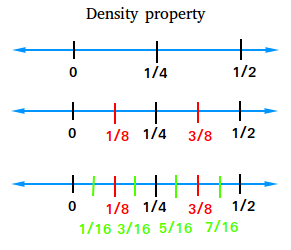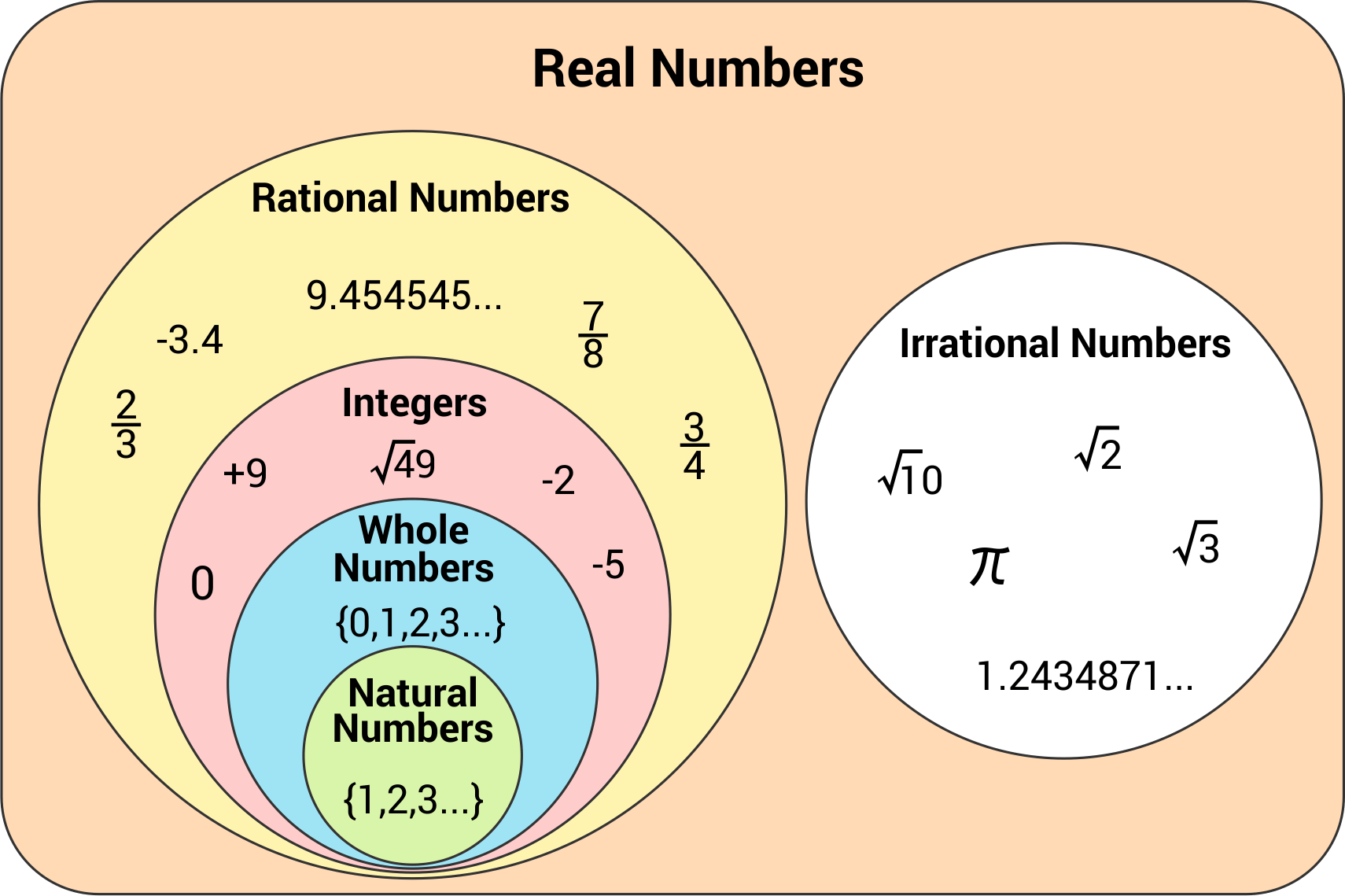Rational Numbers
Here is a detailed, emoji-enhanced guide to rational numbers, ordering, GCD, and density, with diagrams and markdown image code for added visuals.
Learning Outcomes:
- Define rational numbers.
- Order and compare rational numbers.
- Find the greatest common divisor of two integers.
- Understand why rational numbers are dense on the number line.
🧮 Define Rational Numbers
A rational number is any number that can be written as a fraction $\frac{p}{q}$, where $p$ and $q$ are integers and $q \neq 0$.123
- Examples: $\frac{1}{2}, -\frac{3}{4}, 2, 0.3$ (which is $\frac{3}{10}$), and $-5$ (which is $\frac{-5}{1}$).24
- All integers and whole numbers are rational since they can be written as fractions too.45
- Denoted by the set $\mathbb{Q}$.1
📊 Order and Compare Rational Numbers
To compare rational numbers, write them as decimals or with a common denominator.
- Example: Compare $\frac{2}{3}$ and $\frac{3}{5}$:
- When ordering a list, convert all to decimals or use common denominators.
🏆 Find the Greatest Common Divisor (GCD)
The GCD (greatest common divisor) of two numbers is the largest number that divides both exactly.
- Example: GCD of 12 and 26:

- Visual method: List factors or use the Euclidean algorithm (keep dividing and taking remainders).
🌈 Rational Numbers Are Dense on the Number Line
Density means between any two rational numbers, there’s always another rational number!
- Example: Between $\frac{1}{2}$ and $\frac{3}{4}$, the average $\frac{1}{2} + \frac{3}{4}/2 = \frac{5}{8}$ is in between.
- No matter how close two rational numbers are, you can ALWAYS find another rational number between them.111213
- On the number line, rational numbers fill it densely and continuously.

📝 Summary Table
| Concept | Definition/Method | Diagram/Emoji |
|---|---|---|
| Rational Numbers | Fractions $\frac{p}{q}$, integers, recurring decimals | 🧮, 1 |
| Compare & Order | Convert to decimals, common denominators | 📊, 6 |
| GCD | Largest shared factor, Euclidean algorithm | 🏆, 8 |
| Rational Density | Always a rational between any two rationals | 🌈, 11 |
Let these visual tools and emojis help reinforce your understanding of rational numbers and their properties!
Exercise Questions 🤯

1. Which of the following option(s) is (are) true?
A) $ \frac{4}{7} > \frac{5}{8} $
B) $ \frac{17}{22} > \frac{13}{18} $
C) $ \frac{11}{7} > \frac{13}{8} $
D) $ \frac{7}{15} < \frac{5}{20} $
Detailed Solution:
A) $ \frac{4}{7} > \frac{5}{8} $
Find a common denominator:
$4/7 = 32/56$, $5/8 = 35/56$
$32/56 < 35/56$
So, $4/7 < 5/8$. Not true.
- B) $ \frac{17}{22} > \frac{13}{18} $
Find a common denominator:
$17/22 = (17 \times 18) / (22 \times 18) = 306/396$
$13/18 = (13 \times 22) / (18 \times 22) = 286/396$
$306/396 > 286/396$
So, $17/22 > 13/18$. True.
- C) $ \frac{11}{7} > \frac{13}{8} $
Convert to improper fractions with common denominators:
$11/7 = (11 \times 8)/(7 \times 8) = 88/56$
$13/8 = (13 \times 7)/(8 \times 7) = 91/56$
$88/56 < 91/56$
So, $11/7 < 13/8$. Not true.
- D) $ \frac{7}{15} < \frac{5}{20} $
$7/15 \approx 0.4667$, $5/20 = 0.25$
$0.4667 > 0.25$
So, $7/15 > 5/20$. Not true.
Correct Answer: Only option B is true.
2. Which of the following option(s) is (are) in reduced form?
A) $ \frac{5}{60} $ B) $ \frac{12}{27} $ C) $ \frac{11}{18} $ D) $ \frac{13}{91} $
Detailed Solution:
- A) $ \frac{5}{60} $: Both numerator and denominator divisible by 5. $5/60 = 1/12$. Not reduced.
- B) $ \frac{12}{27} $: Both divisible by 3. $12/27 = 4/9$. Not reduced.
- C) $ \frac{11}{18} $: 11 and 18 have no common factors other than 1. This is reduced form.
- D) $ \frac{13}{91} $: 91 = 7 × 13. Both divisible by 13. $13/91 = 1/7$. Not reduced.
Correct Answer: Only C is in reduced form.
3. Let gcd(a,4) = 2 and gcd(a, b) = 1. If 4 > a > b and a, b are natural numbers, then the values of a and b are respectively
A) 2, 1 B) 1, 2 C) 2, 4 D) 4, 2
Detailed Solution:
- $gcd(a,4) = 2$: $a$ must be even but not divisible by 4. Since $a < 4$, possible $a$ is 2.
- $gcd(a,b) = 1$: $a$ and $b$ are coprime.
- Since $a = 2$ and $a > b$, try $b=1$: $gcd(2,1) = 1$ ✓
Hence, values are $a=2$, $b=1$.
Correct Answer: A) 2, 1
Summary Table
| Qn | Correct Option | Explanation |
|---|---|---|
| 1 | B | $17/22 > 13/18$ is true; others are false. |
| 2 | C | $11/18$ is the only fraction in reduced form. |
| 3 | A | Only $a = 2, b = 1$ fit all GCD and ordering conditions. |
https://www.slideshare.net/slideshow/7-lesson-42-compare-and-order-rational-numbers/122114001 ↩︎ ↩︎ ↩︎
https://study.com/academy/lesson/comparing-ordering-rational-numbers.html ↩︎
https://www.splashlearn.com/math-vocabulary/greatest-common-divisor-gcd ↩︎ ↩︎ ↩︎
https://www.cuemath.com/numbers/greatest-common-divisor-gcd/ ↩︎
https://www.slideshare.net/slideshow/densityof-numberline/29878041 ↩︎ ↩︎ ↩︎
https://www.geeksforgeeks.org/maths/what-is-the-density-property-of-rational-numbers/ ↩︎
https://www.slideshare.net/slideshow/densityof-numberline-30862263/30862263 ↩︎
